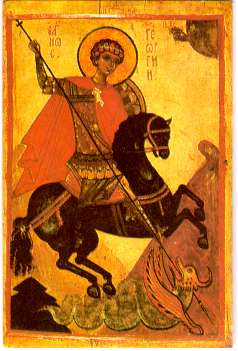 23 April:
George, Martyr, Patron of England, c.304:
George is a soldier and martyr who suffered around 303 at Lydda
(Diospolis) in Palestine. The earliest surviving record of him is a
church inscription in Syria, dated about 346. Commemorations of him
are numerous, early, and widespread. However, no details of his life
are known. In 495 his name appears on a list of "good men, justly
remembered, whose good deeds are known only to God." The best-known
story about him is that he rescued a beautiful princess in Libya by
killing a dragon. It should be noted that this story appears only at
the end of the Middle Ages, shortly before the invention of
printing.
23 April:
George, Martyr, Patron of England, c.304:
George is a soldier and martyr who suffered around 303 at Lydda
(Diospolis) in Palestine. The earliest surviving record of him is a
church inscription in Syria, dated about 346. Commemorations of him
are numerous, early, and widespread. However, no details of his life
are known. In 495 his name appears on a list of "good men, justly
remembered, whose good deeds are known only to God." The best-known
story about him is that he rescued a beautiful princess in Libya by
killing a dragon. It should be noted that this story appears only at
the end of the Middle Ages, shortly before the invention of
printing.When the soldiers of the First Crusade were besieging Antioch (around 1200?), they had a vision of George and Demetrius (a deacon of Sirmium in Serbia, martyred under Maximian, and referred to as a "soldier of Christ," from which he was often understood to be a literal soldier) encouraging them to maintain the siege, which ultimately proved successful. Richard I ("the Lion-Heart") of England placed himself and his army under George's protection, and with the return home of the Crusaders, the popularity of George in England increased greatly. Edward III (1227-1277) founded the Order of the Garter under his patronage, and Henry V spoke of him to rally the troops before the battle of Agincourt ("Once more unto the breach, dear friends, once more, or close the wall up with our English dead!"), and in the years following George was regarded as the special patron of England, of soldiers, and of the Boy Scouts, as well as of Venice, Genoa, Portugal, and Catalonia. He is also remembered with enthusiasm in many parts of the East Orthodox Church. He is a principal character in Edmund Spenser's allegorical poem THE FAERIE QUEENE, written in the late 1500s.